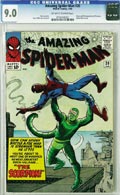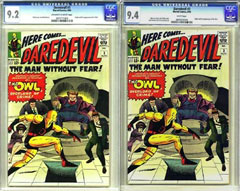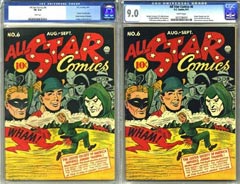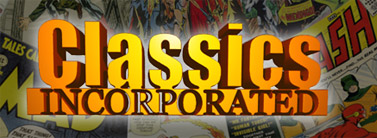Pressing Service
One of the most revolutionary processes to be developed
this decade, pressing has seen its fair share of attention
in the hobby. The purpose of pressing is to raise a high
grade comic to an even higher grade by removing small
defects using
non-restorative techniques. For example, a Amazing
Spider-man #20 graded CGC 9.0 could possibly raise to
9.2 or even 9.4 with pressing.
But finding the right candidates for pressing takes
practice. There are several factors that must be considered,
like identifying "good" and "bad" defects,
value increase vs. cost, and encapsulated candidates vs.
raw candidates. Following the sections below will help you
make an informed decision and which books are suitable for
pressing. "Good" defects versus "bad" defects
The first step is to identify a comic book's
"good" defects and "bad" defects. In short, good defects
can be diminished or removed with pressing, and the bad
defects cannot. Here is a list of
both:
|
Good defects (do
not break color) |
Bad defects |
Dents
Bends
Folds
Light creases
Minor spine stresses
Impacted corners or edges
Slight warping
Ripples
Slight spine rolls
Waviness
Light cover impressions
Light pencil marks
Dirt |
Creases that break color
Missing chips or pieces
Tears
Stains
Detached staples or staple tears
Spine stresses that break color
Fading
Fingerprints
Dust shadows or Sun shadows
Rusted staples or rust stains
Rounded or blunted corners
Pen markings
Cover veins |
 Just
because a comic may exhibit good defects does not mean it
will automatically increase in grade with a pressing. For
example, the afore mentioned Spidey #20 in CGC 9.0 may have an impacted corner that does not break
color. But upon closer inspection a small ¼” color-breaking
crease is discovered on the bottom corner of the front
cover. Even if the impact is completely pressed out, that
crease will keep the book from grading 9.2. this would not
be a good pressing candidate. Just
because a comic may exhibit good defects does not mean it
will automatically increase in grade with a pressing. For
example, the afore mentioned Spidey #20 in CGC 9.0 may have an impacted corner that does not break
color. But upon closer inspection a small ¼” color-breaking
crease is discovered on the bottom corner of the front
cover. Even if the impact is completely pressed out, that
crease will keep the book from grading 9.2. this would not
be a good pressing candidate.
A solid understanding of CGC’s grading
standards is essential to determine how each defect will
affect a book’s upgrade potential. Because of the thousands
of comics we submit to CGC each year, we are among the most
experienced with their standards. This makes our
proscreening process very
accurate. And if you follow this list of defects closely,
you’ll enjoy a much higher success rate with the books you
choose as potential candidates.
Using a formula to determine
candidacy
Just because a comic can increase in grade from pressing
does not mean it’s worth doing. Value and grade increase
should be weighed against cost to make sure the book is worth pressing. There is a
very simple formula to follow when considering your comics
for pressing:
|
(Press fees + grading
fees + shipping) < (est. grade value
minus cost of comic) |
Let’s use that Spidey #20 we’ve been talking
about as an example. Say you paid $900 for
your 9.0 copy. A 9.2 copy is worth about $1,400 according
to GPAnalysis.com,
which would be a $500 increase in value.
Applying the formula, we get:
| ($75 + $63.20 +
$30) = $168.20 |
(left side of the equation, or your
cost to press, grade, and ship) |
| ($1,400 - $900)
= $500 |
(right side of the equation, or your
potential profit) |
| = $168.20 <
$500 |
(the potential profit is clearly
higher than the cost) |
|
If the book don’t get the 9.2 upgrade, $168 has been spent.
But if it does, the value increases by $332. So the overall
reward is double the potential risk. Not a bad gamble,
especially if we think the book is a good pressing
candidate.
Another example involves an inexpensive Bronze Age comic, where the margin between risk and reward
is more narrow. This time it's a raw copy of Iron Fist
#15, for which you paid $200. The book is gorgeous, and
you’re hoping for a 9.6 with pressing, but it looks like
there is a slim chance at 9.8.
GPAnalysis shows 9.6 copies
selling for around $275. So your formula would be:
| ($25 + $12 +
$30) = $67 |
(left side, your cost) |
| ($275 - $200) =
$75 |
(right side, your potential profit
for 9.6) |
| = $67 < $75
|
|
|
In this case, your potential gain is a
mere $8 for a 9.6. But what if it graded 9.8? There are no
9.8 copies on
CGC’s census.
If it did grade 9.8, the book could be worth around $1,000. Even if there is only a slim
chance the book could get a 9.8, the Iron Fist would still be worth pressing and grading because there
almost no risk involved.
Everyone has a different threshold for risk, and some
collectors may be willing to take on more risk for an
upgrade, even if it means losing money because the desired
grade is not achieved. Other collectors simply want a
higher grade for their collection, and value increase is not a
factor.
Submitting several books at once tends to
yield better results because any potential risk is spread
out. You’re not putting all of your
eggs in one basket, so to speak. We’re happy to discuss your
objectives with you, and offer further advice on any books
you're submitting for proscreen.
Establishing grade and value thresholds
Any comic, no matter how old or new it is, can benefit from
pressing. But there are thresholds below which value or
grade increases do not justify the cost of pressing and
grading. There are always exceptions to each rule, but if
you generally stay at or above these thresholds, the results
are satisfactory.
 |
| This copy of
Daredevil #3 was originally a 9.2, but close
inspection
revealed visible defects that could be corrected
with pressing. After the pressing, the book was shipped to CGC for grading. It received a 9.4, doubling
its value from $750 to $1,500 for a cost of $75
plus grading fees. |
Modern Age Comics (1980-present)
Press to 9.8 or
higher
Bronze Age Comics (1970-1979)
Press to 9.6 or
higher
Bronze Key Issues (i.e. Spidey #122)
Value increase > $75
Or overall book value > $250
Silver Age Comics (1956-1969)
Value increase more
than $100,
Or overall value greater than $250
Golden Age Comics (1933-1955)
Value increase more
than $100,
Or overall value greater than $250
There are many exceptions to these guidelines. For instance,
because the Golden Age market is more concentrated than
Silver or Bronze comics, grade increases don't necessarily
translate into a specific percentage increase of value. But
Golden Age comics are much scarcer, and there is a greater chance a Golden
Age book could become the single highest graded copy, thus
dramatically increasing its desirability. Other resources
should be included when determining a book's candidacy, such
as the CGC population report and
GPAnalysis.
Encapsulated comics versus raw comics
 |
|
This copy of Spidey #130 was part of a
collection of high grade Bronze Age Marvels, but
many
suffered from the slightest handling wear such
as finger dents and slight bends to the edges.
The entire
collection was proscreened for 9.6 or better,
and yielded about
100 books that were candidates for conservation
and grading. After the work was performed and
the books were graded by CGC, the results were
four 9.2's, twelve 9.4's, seventy-six 9.6's, and
eight 9.8's. The average cost per book
(including pressing and grading), was $62. This
single Spidey in 9.8 is alone
worth $650. |
Considering encapsulated comics for pressing requires a more
concentrated effort than raw comics. For encapsulated
comics, the grade has already been established and the
comic has been checked for restoration. But it's harder to
evaluate a comic through two layers of plastic. Also, graded
comics tend to raise the value of the right side of the
equation, shrinking the margin for candidacy.
On the flip side, raw comics must be carefully checked for
hidden defects and restoration. But if a raw comic passes both
inspections with flying colors, and its potential grade
justifies the cost, pressing is usually recommended.
Generally speaking, potential candidates are more plentiful
among raw comics.
Because restoration has been our business for over a decade,
we are among the most experienced in the hobby at spotting
it. We have also pressed many raw and CGC-graded comics over the
years, allowing us to develop a sophisticated method of
evaluation, and a very high success rate for upgrades.
We strive to make sure every technique is safe for the
short and long term. Our pressing process does not involve
disassembly, nor do we use abrasive materials like
chemicals, or perform any work that would constitute
restoration. No excessive pressure or heat is used in our
work. You will not receive comics that appear to be "pancaked,"
or any other unfortunate side effect that usually occurs
with improper pressing. The end result is undetectable, with
each comic exhibiting a fresh, untouched feel and look.
 |
|
This All-Star #6, originally graded CGC 8.0,
exhibited numerous defects that were correctable
using pressing. After the work was completed,
the All-Star #6 was resubmitted to
CGC, and received a 9.0. Cost of pressing was
$75. |
Currently our turn time is 4-5 weeks. This time includes
evaluation, pressing, packing and shipping. Your comics can
also be mailed directly to CGC for grading after work is
completed. CGC fees will be included on your invoice, and
CGC will mail the books directly back to you after grading.
CGC invoice numbers will be provided to you for tracking
purposes. To submit comics for pressing, or any other
service you may need, please go here.
|
